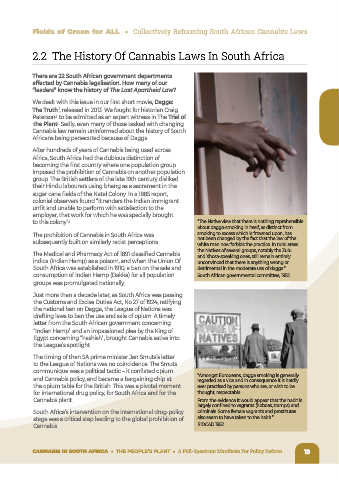Page 63 - Daggabay Magazine Issue 9
P. 63
Fields of Green for ALL • Collectively Reforming South African Cannabis Laws
2.2 The History Of Cannabis Laws In South Africa
There are 22 South African government departments
affected by Cannabis legalisation. How many of our
“leaders” know the history of The Last Apartheid Law?
We dealt with this issue in our first short movie, Dagga:
The Truth , released in 2013. We fought for historian Craig
2
Paterson to be admitted as an expert witness in The Trial of
3
the Plant . Sadly, even many of those tasked with changing
4
Cannabis law remain uninformed about the history of South
Africans being persecuted because of Dagga.
After hundreds of years of Cannabis being used across
Africa, South Africa had the dubious distinction of
becoming the first country where one population group
imposed the prohibition of Cannabis on another population
group. The British settlers of the late 19th century disliked
their Hindu labourers using bhang as a sacrament in the
sugar cane fields of the Natal Colony. In a 1885 report,
colonial observers found “it renders the Indian immigrant
unfit and unable to perform with satisfaction to the
employer, that work for which he was specially brought
to this colony” . 5 “The Native view that there is nothing reprehensible
about dagga-smoking in itself, as distinct from
The prohibition of Cannabis in South Africa was smoking to excess which is frowned upon, has
not been changed by the fact that the law of the
subsequently built on similarly racist perceptions. white man now forbids the practice. In rural areas
the Natives of several groups, notably the Zulu
The Medical and Pharmacy Act of 1891 classified Cannabis and Xhosa-speaking ones, still remain entirely
indica (Indian Hemp) as a poison , and when the Union Of unconvinced that there is anything wrong or
6
South Africa was established in 1910, a ban on the sale and detrimental in the moderate use of dagga.”
consumption of Indian Hemp (Dakka) for all population South African governmental committee, 1952
groups was promulgated nationally.
Just more than a decade later, as South Africa was passing
the Customs and Excise Duties Act, No.27 of 1924, ratifying
the national ban on Dagga, the League of Nations was
drafting laws to ban the use and sale of opium. A timely
letter from the South African government concerning
“Indian Hemp” and an impassioned plea by the King of
Egypt concerning “hashish”, brought Cannabis sativa into
the League’s spotlight.
The timing of then SA prime minister Jan Smuts’s letter
to the League of Nations was no coincidence. The Smuts
communique was a political tactic – it conflated opium “Amongst Europeans, dagga smoking is generally
and Cannabis policy, and became a bargaining chip at regarded as a vice and in consequence it is hardly
the opium table for the British. This was a pivotal moment ever practised by persons who are, or wish to be
for international drug policy, for South Africa and for the thought, respectable.
Cannabis plant. From the evidence it would appear that the habit is
largely confined to vagrants (hoboes, tramps) and
South Africa’s intervention on the international drug-policy criminals. Some female vagrants and prostitutes
stage was a critical step leading to the global prohibition of also seem to have taken to the habit.”
Cannabis. RIDCAD 1952
CANNABIS IN SOUTH AFRICA • THE PEOPLE’S PLANT • A Full-Spectrum Manifesto For Policy Reform 19

